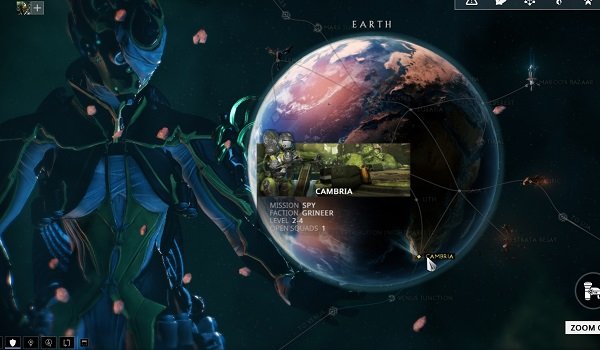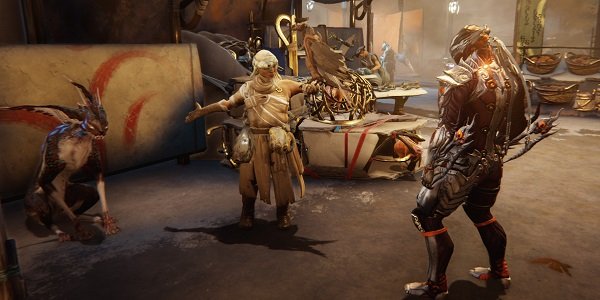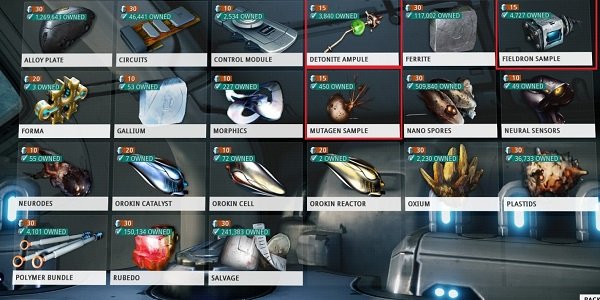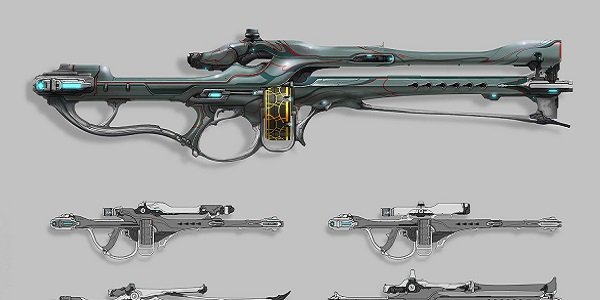Warframe: Everything You Need To Know To Get Started

So you're finally ready to dive into Warframe. Great! But before you rush off to become a space ninja, we have a few tips to offer that should make those first dozen hours a bit less overwhelming.
Following the reveal of some impressive-looking future updates and the announcement that Warframe is coming to the Nintendo Switch, interest in the free-to-play action game has skyrocketed. And while the opening chapters serve as a decent gameplay tutorial, Warframe is packed with systems that are notoriously obtuse. There are a lot of interconnecting parts at play here, which can be very overwhelming for a new player.
The purpose of this guide is to make those opening hours a bit more user friendly because, once you get rolling, there's a lot of fun to be had in this bombastic run-and-gun adventure.

Follow the breadcrumbs
There are two important things to keep in mind when you first begin playing Warframe: It's kind of an MMO and it's also a free-to-play game. The thing both of those genres have in common is that they are typically filled with oodles of systems meant to keep the player coming back for more. The good news is that Warframe is an example of free-to-play done right, with the vast majority of in-game items available simply by grinding through missions. Still, we're looking at systems stacked on systems stacked on systems, which can make your head spin if you try to grasp everything at once.
Instead of trying to take everything in at once, do your best to build a sort of tunnel vision when you first start playing. You'll constantly be asking things like "what is that resource for," "what item did I just pick up" or "where do I get a cooler gun." You'll get those answers, but they're frequently inconsequential in the opening hours of play.
Instead, we recommend picking your starting Warframe and gear and just dive into missions. If you keep your head down and simply follow the introductory story, you'll be led naturally from one objective to the next. This will allow you to focus on the mechanics and get better at playing the game. We also recommend you play solo for these opening hours. The missions are seldom overwhelming and, that way, you won't be dealing with the added stress of "weighing your team down as a total noob."
The further you go, the more systems will be naturally revealed to you. Again, we recommend only giving them a cursory glance until you feel like you've got a decent understanding of how the core mechanics work.
Your Daily Blend of Entertainment News

Digging deeper
Once you've got a feel for the basic mission structure, it's time to start digging into some of the additional systems at play in Warframe. The moment you start to feel overwhelmed, go back to playing missions and grinding for loot. The beauty of Warframe is that there really isn't a wrong way to play the game. If you're not ready to learn more, don't force the issue.
Many of Warframe's systems are represented as consoles on your ship. You can walk around and interact with those various consoles but, if you prefer, you can also bring up a menu and simply select your desired destination from a handy list. You'll be able to craft new items in the Foundry, swap out your mods and, of course, start tooling around with your loadout.
To help you along, one console will come in very handy. If you're standing at the front of your ship and looking out the window, this is the console on the far left. Sort of like the Grimoire in Destiny, this console has detailed explanations of gear, enemies, missions types, etc. If you're having trouble understanding something, the answer may be found there.

Loot, loot *and*more loot
As with many MMOs and free-to-play games, Warframe is absolutely packed with loot and is constantly being updated. There are dozens of different types of resources to farm, all of which can be spent on crafting weapons, new Warframes, equipment and the like. While you're running through missions, be sure to slice through every blinking container and pop open every storage chest with a green light. Again, in the early goings, don't even worry about what you're picking up. There is no cap on your resource pool, so just keep snagging all of those glowing goodies. Later, when you're ready to start building new gear, you'll want to spend more time learning which planets have which resources and farm those missions for your desired items.
If you take the time to explore and grab loot while running missions you'll likely find that, once you're ready to start building new gear, you've already got plenty of resources to craft a gun, sword, etc. without having to farm. If you see you're lacking a certain resource to make something, you probably haven't reached a planet that has said resource available. Just get back to playing missions and you'll get there eventually.

That mod bod
If you notice the missions are actually becoming a bit difficult, it's probably time to finally start diving into more of the game's systems. The three areas to focus on here are mods, equipment and building gear at the Foundry.
We'll start with mods because they're the easiest to tackle even though they seem damn-near impenetrable in the early goings. Once the Mod station becomes available, you'll be able to attach boosts to your Warframe and all of your major equipment. Our suggestion is that you rely completely on the option to automatically attach mods. You'll want to learn more about mods deeper in the game but, in the early goings (which can literally be dozens of hours), you can completely avoid a lot of stress by falling back on auto equip.
Rather than work from the mod station, simply enter your equipment manager. Under each piece of equipment is an option to "Upgrade." Select that option and, from there, select the "Auto" option. Boom, your gear is now stronger. Do that for each piece of gear including your Warframe, individual weapons, etc. The important thing is that you remember to go in and do the exact same thing at least once per play session since you'll constantly be picking up new mods on the battlefield and hitting auto will usually swap out mods so that your gear is as powerful as it can be.

If you build it...
Leveling in Warframe is a little tricky. As you play missions, all of your gear will level up individually. That, plus your progression across the map, as well as various other in-game factors, will build toward your Mastery Rank. The Mastery Rank is explained within the game, so we won't confuse matters by digging into it further here.
Instead, just know that every piece of gear tops out at Rank 30 so, if your gear isn't at that rank, it hasn't benefitted you to its maximum potential. When a piece of gear hits rank 30, though, it's time to swap it out with something else and get back to grinding. Again, you can play however you like with whatever gear that you like, but this is an important step if you want to keep progressing your Mastery Rank.
When you've got some resources piled up, it's time to head to the in-game store. Let's say you want to make a new primary weapon. Head to that tab in the store and be sure to switch the display to "blueprints only." From that list, pick the weapon you want and select its blueprint. The blueprint shows exactly how many/what type of resources you need, so you'll know immediately if you've still got some grinding to do or if you can just build the desired weapon. We'd recommend picking something you've already got the resources to build and purchasing it using the in-game currency. From there, you can head to the Foundry, select the blueprint and spend the resources to start building it. You'll actually want to do this before your current gear hits rank 30 because building most items takes at least 12 real-world hours. Don't worry; the clock is still ticking even when you aren't playing the game.
When your current gear hits 30, swap it out for the freshly-built gear and get back to the grind. This process is a big driving factor in leveling up your character, and it also keeps you trying out all sorts of new gear.

Spend your Platinum wisely
When you start playing Warframe, you'll likely be granted a decent pool of Platinum. This is the one resource you seldom get in the game proper, so you'll want to spend it sparingly. The main way to get more Platinum is to spend real-world money.
Since a bunch of stuff in the game, including Warframes, can be purchased with Platinum, it can be tempting to spend yours on some gear you just really want. We'd strongly encourage against that. Instead, the best way to spend your free Platinum is on extra "slots," which are available for purchase in the store. You can only build as many Warframes and weapons as you have slots to hold them, so you'll definitely want to fork over some Platinum to earn more storage space at some point.
Again, just about everything else in the game can be farmed and built from scratch so, as much as you might like to spend Platinum on that cool-looking sword, you'll be able to build it yourself at some point down the road.
Of course, there's also nothing wrong with forking over a few bucks for a free-to-play game you're getting hours of fun out of. If you dive into Warframe and find you're having a blast, then dropping some fresh Platinum into your account is a good way to compensate the developer who made the game while treating yourself to some sweet gear you don't have to grind for.
Staff Writer for CinemaBlend.

